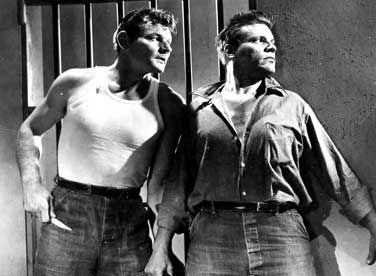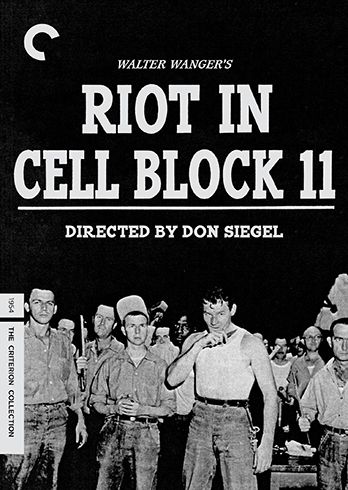Don Siegel’s Riot in Cell Block 11 is the perfect sort of film for the Criterion Collection to shine the spotlight on. The film doesn’t have a lot of famous names in the cast (the most notable is Neville Brand), while it’s rarely mentioned as one of Siegel’s best (a distinction often given to Dirty Harry by default, but also in the conversation would be Charley Varrick and Invasion of the Body Snatchers), but definitely deserves to be reconsidered, as this tight narratives about the problems in a prison population is fascinating – it’s a low budget marvel. My review of the Criterion Collection edition of Riot in Cell Block 11 follows after the jump.
The movie starts with a ripped from the headlines “News on the March”-style presentation about the then-relevant data about recent prison riots. We then go into a prison (played by Folsom, the prison made famous by Johnny Cash), where we meet an assortment of inmates. Some are rough, and some just want to get word to their wife. But as the cell block is closing up for the night, one inmate is able to subdue a guard, which leads to nine guards being taken prisoner. This sequence also shows Siegel’s understanding of his budget and how to use the camera effectively as the visuals are often static until a moment where the camera follows the prisoners as they stalk a guard.
Eventually Cell Block 11 is taken over, and James V. Dunn (Brand) is put in charge, but we also hear from the Warden Reynolds (Emile Meyer), who voices his problems with the prison as well, and his complaints are similar to Dunn’s. For the men in the prison, they have to worry about the additional police and security brought in to stop them – which mean them dynamiting the entire block -- while Dunn has to maintain control in a situation where some of the men are just there because they made a mistake or two and have no interest in rioting, while others are psychopaths who may prefer just to kill the guards given the opportunity.
The film was made by producer Walter Wanger, who had just served some time in prison before making the movie, and the film has the anger of someone who felt the system betrayed him. But the film doesn’t paint either the criminals or the people who work in the prison as the bad guys, it’s the way prisons are treated by the government, and how it often causes the people in them to become institutionalized as it’s the only life they know. As such there are no happy endings, but that noted, the film feels free to go in any direction. Like a horror movie, you never know if it’s going to end in something more apocalyptic or where the win could be, or who could come out on top.
Basically, Criterion has resurrected this film, and in a time where America needs to have a conversation about what’s changed since this film was made and how we as a culture deal with incarceration, it’s as vital now as when it was made.
The Criterion release comes with the Blu-ray and DVD copy of the film. The film is presented in full frame (1.33:1) and in 1.0 DTS-HD monaural, and the transfer is a stunner considering the film is sixty years old. Criterion did a full 4K restoration, and it shows. The blacks are pure and there’s very little noticeable damage. The film comes with a commentary by Matthew H. Bernstein, who wrote a biography on the film’s producer Wanger, and he makes for an entertaining guide through the movie. The supplements are limited to audio recordings: “Don Siegel on Riot in Cell Block 11” (26 min.) offers Siegel’s son Kristofer Tabori reading a chapter on the film from the American director's autobiography, A Siegel Film, as he also does in “Excerpt From Don Siegel: Director” (13min.) which includes an interview with Neville Brand. “The Challenge of Our Prisoners” (60 min.) offers audio excerpts from journalists Peg and Walter McGraw's NBC radio documentary series that covered the problems with prisons at the time. Considering everyone who made this film is likely to be dead, this is the best case scenario for supplements.



